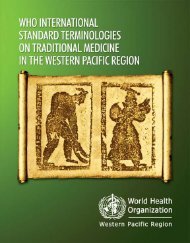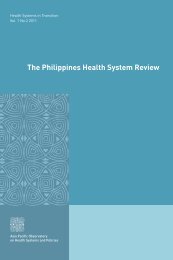Building capacity for NCD prevention and control meeting
Building capacity for NCD prevention and control meeting
Building capacity for NCD prevention and control meeting
Create successful ePaper yourself
Turn your PDF publications into a flip-book with our unique Google optimized e-Paper software.
12<br />
REPORT: REGIONAL MEETING ON PREVENTION AND CONTROL OF <strong>NCD</strong><br />
Part 1<br />
<strong>Building</strong> Capacity <strong>for</strong> <strong>NCD</strong> Prevention <strong>and</strong> Control<br />
FIGURE 2. Spidergram indicating average political support <strong>and</strong> programme <strong>capacity</strong> <strong>for</strong> RAP objectives<br />
Monitoring<br />
<strong>and</strong><br />
Evaluation<br />
Partnerships<br />
Advocacy<br />
4<br />
3<br />
2<br />
1<br />
0<br />
Research<br />
Policy<br />
Population<br />
Interventions<br />
Political Support<br />
Programme Capacity<br />
The spidergram indicates that, on average, there is moderate political support <strong>and</strong> programme <strong>capacity</strong> <strong>for</strong><br />
most of the objectives. For policy <strong>and</strong> monitoring <strong>and</strong> evaluation, there is more political support than <strong>for</strong><br />
programme <strong>capacity</strong>, suggesting that the biggest gains may be made by improving programme <strong>capacity</strong><br />
in these areas. For research <strong>and</strong> partnerships, programme <strong>capacity</strong> is stronger than political support,<br />
suggesting that eff ort should be put into garnering political support in these areas. All areas, however,<br />
would benefi t from boosts in <strong>capacity</strong> <strong>and</strong> political support.<br />
To complete workshop activities on day 1, participants were invited to vote <strong>for</strong> their top three areas where<br />
action was most needed. The overall results are summarized in Table 2.<br />
TABLE 2: Areas where action is most needed in the next two years<br />
Advocacy Policy Population interventions Research Partnerships Monitoring <strong>and</strong> evaluation<br />
3 11 7 5 6 7<br />
The key areas were identifi ed as policy, population interventions <strong>and</strong> monitoring <strong>and</strong> evaluation <strong>and</strong> it was<br />
agreed that, <strong>for</strong> day 2 of the workshop, Cambodia, the Lao People’s Democratic Republic <strong>and</strong> Viet Nam would<br />
progress work on Policy; the Pacifi c isl<strong>and</strong> countries would progress work on Population interventions; <strong>and</strong><br />
China, Malaysia, Mongolia <strong>and</strong> the Philippines would progress work on Monitoring <strong>and</strong> evaluation.<br />
Summary <strong>and</strong> output of day 1<br />
The planned output of an overview of country progress <strong>and</strong> assessment of political support <strong>and</strong> programme<br />
<strong>capacity</strong> in relation to the <strong>NCD</strong> RAP, <strong>and</strong> development of a list of priority action areas was achieved. At<br />
the end of day 1, each country could point to three or four areas <strong>for</strong> action to improve <strong>NCD</strong> <strong>prevention</strong><br />
<strong>and</strong> <strong>control</strong> <strong>and</strong> explain why they were considered priorities. Collectively, this in<strong>for</strong>mation is also useful <strong>for</strong><br />
development agencies to identify what areas require most support across the Region.<br />
In the process, there was healthy discussion over whom the priorities were <strong>for</strong> <strong>and</strong> why a set of agreed<br />
regional objectives needed prioritization. It was noted that (1) the training was primarily designed to

















